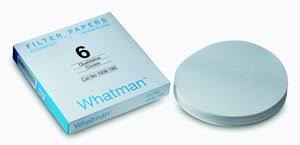Cellulose filters are used in qualitative analytical techniques to determine and identify materials.
Prepleated qualitative filters are available, which give improved flow rate and increased loading capacity compared to equivalent flat filters.
Cellulose filters are used in qualitative analytical techniques to determine and identify materials.
Prepleated qualitative filters are available, which give improved flow rate and increased loading capacity compared to equivalent flat filters.
| Variation Codes | 1006-090 |
|---|
Grade 50: 2.7 μm*
Retention of very fine crystalline precipitates.
The thinnest of all Whatman filter papers with a slow flow rate, these filters have a hardened and highly glazed surface, which also keeps the paper free from loose surface fibers.
Highly suitable for
qualitative or quantitative filtrations requiring vacuum assistance on Büchner
or 3-piece filter funnels.
Very strong when wet and will withstand wet handling and
precipitate removal by scraping.
In the electronics industry, the virtual absence of
fiber shedding is utilized in carriers for integrated circuits.
This grade is also available in Smear Tab format for wipe testing (e.g. testing of
surfaces for radionuclide contamination).
Slightly more retentive than Grade 1 with a corresponding increase in filtration time (i.e., slightly slower filtration speed).
More absorbent than Grade 1. In addition to general filtration in the 8 μm particle size range, the extra absorbency is utilized, for example, to hold soil nutrient in plant growth trials.
Also used for monitoring specific contaminants in the atmosphere and in soil testing.
Grade 54: 22 μm*
Very fast filtration and high wet strength makes this grade very suitable for vacuum
assisted fast filtration of difficult coarse or gelatinous precipitates.
Grade GF10 Reel 35 mm x 30 m Core 70 mm 1/PK
This filter with extreme mechanical stability and temperature resistant up to 180°C is used
as a weighing aid for infrared weighing and as a roll filter in automatic air filtration units.
Select at least 2 products
to compare

There are no reviews yet.